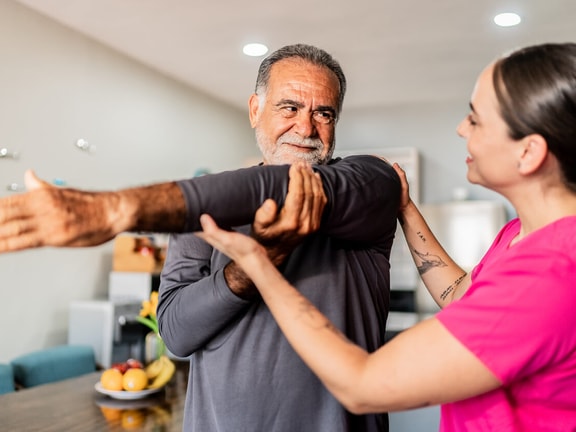Shoulder Pain: When Posterior Restrictions Cause Anterior Symptoms
Help patients with anterior shoulder pain by addressing the underlying cause, not just the painful site. This guide shows you how to assess, treat, and resolve pain by targeting posterior restrictions and faulty mechanics.
May 13, 2025
7 min. read

Anterior shoulder pain is a common report in orthopedic practice. But in many cases, the discomfort at the front of the shoulder isn’t the true source—it’s a symptom of dysfunction in the back of the shoulder that alters joint mechanics.
A frequently overlooked contributor is the anterior humeral glide—not due to instability, but from limited mobility in the posterior capsule or rotator cuff. This restriction shifts stress to the front of the shoulder, even though the underlying dysfunction begins in the back.
Shoulder Impingement Exercises PDF
Fill out the form to unlock your free shoulder impingement exercises PDF!

Glenohumeral arthrokinematics: Glide and roll
In normal shoulder mechanics, the humeral head stays centered in the glenoid fossa throughout movement. This concept, known as joint centration or the path of instantaneous center of rotation (PICR), relies on adequate mobility, muscle performance, and neuromuscular control.1
When the posterior capsule, infraspinatus, or teres minor are stiff, the humeral head can't glide backward as it should, particularly during internal rotation or when reaching across the body. Instead, it may shift forward, increasing stress on anterior structures in the shoulder, such as the biceps tendon or anterior capsule.
The altered mechanics often present as pain or discomfort at end-range horizontal adduction and internal rotation, especially during functional tasks, like putting on a seatbelt or reaching behind the back.
Recognizing an anterior humeral glide
Identifying anterior humeral glide starts with determining whether a mobility restriction is present and whether that restriction contributes to pain. The assessment typically includes postural observation to evaluate the resting position of the shoulder, along with mobility testing to identify which posterior structures may be limiting motion. A final and essential step is the use of a symptom modification procedure. This involves having the person perform a movement that normally provokes pain, then applying a manual or positional adjustment—such as changing the glide of the humeral head—to see if the pain is reduced.
Step 1: Start with posture
Begin by evaluating the patient’s resting posture. Look for signs of anterior positioning of the humeral head, such as the humerus sitting forward in the glenoid or a rounded shoulder posture. These findings can indicate a baseline tendency for anterior glide, which is often reinforced during functional movement. Clinically relevant anterior glide is typically when the humeral head appears palpably prominent anteriorly, often more than one-third of the humeral head sitting forward relative to the acromion or glenoid.
Step 2: Assess muscle length and mobility
Once you note postural tendencies, assess for length restrictions in the posterior structures. This includes both the posterior cuff musculature (infraspinatus, teres minor) and the posterior capsule.
Modified Tyler Test (horizontal adduction with overpressure): The Modified Tyler Test is performed with the patient lying on their side, test arm on top. The clinician manually stabilizes the scapula to isolate glenohumeral motion, then moves the arm into horizontal adduction, keeping it level with the shoulder. A positive test is indicated by limited motion compared to the opposite side.2
Internal rotation range of motion: Typical values are 70 degrees of internal rotation and a side-to-side difference greater than 20 degrees.2
Step 3: Joint accessory motion testing
Test posterior glide of the glenohumeral joint to determine joint mobility. Consider the following:
Is the joint hypomobile, normal, or hypermobile?
A hypomobile posterior glide supports the diagnosis of anterior humeral glide syndrome caused by a mobility deficit.
Assessing accessory motion helps clarify whether limited mobility is contributing to faulty arthrokinematics.
Step 4: Symptom modification procedure
To confirm that posterior restriction is contributing to the patient’s pain, use a posterior glide symptom modification test:
Apply a posterior glide during a provocative movement (e.g., reaching across the body).
If this relieves symptoms and mobility testing has indicated a deficit, you now have a strong rationale to target posterior shoulder structures within your intervention plan.
Mobility interventions: Free up the posterior cuff
When anterior shoulder pain stems from mechanical restriction, particularly in the posterior cuff or capsule, restoring motion through focused mobility interventions can significantly reduce symptoms. These techniques are most effective when tailored to the specific movement limitations provoking the pain.
1. Arm across body stretching (horizontal adduction)
Cross-body posterior cuff stretch (wall or table)
Horizontal adduction stretches are ideal when symptoms arise during arm movements across the body. This stretch provides a sustained posterior glide, helping to lengthen the posterior rotator cuff and capsule. It can be performed against a wall or on a table surface—both options are effective and can be chosen based on patient comfort and clinician preference.
Internal rotation stretching
Internal rotation-based stretches are ideal when symptoms arise when reaching behind the back or during tasks involving medial rotation. It is typically performed in side lying but can be modified based on patient comfort.
2. Movement integration and symptom modification
Once posterior mobility is restored passively, integrate that motion into functional patterns that previously reproduced symptoms.
Posterior glide with trunk rotation (Swiss ball or quadruped)
Focus on replicating real-world movements that challenge the shoulder's new range of motion. For example, if a patient experiences symptoms when putting on a seatbelt, you can demonstrate an intervention that mimics the key movements of that task, such as horizontal adduction combined with trunk rotation. One effective exercise option is a seated trunk rotation with a posterior glide applied to the humerus.
When mobility isn’t enough: Movement control PICR
The presentation is often primarily mobility-driven for patients whose symptoms are provoked only at the end range, particularly during internal rotation or horizontal adduction. In these cases, targeted interventions for the posterior cuff and capsule may be all that’s needed. However, if symptoms occur earlier in the range of motion or if mobility restrictions have been addressed but symptoms persist, the issue may not be a mobility deficit but rather impaired movement coordination. This is where the concept of PICR becomes clinically relevant. Even with adequate mobility, failure to maintain humeral head centration can provoke anterior structures in the shoulder.
For a deeper dive into assessing and treating anterior shoulder pain from a motor control perspective—and how to address movement coordination impairments when mobility interventions aren’t enough—refer to the article Reaching Alignment: Joint Centration for Athletes.
Bottom line: Assess posterior mobility to treat anterior shoulder pain
If a patient presents with anterior shoulder pain, particularly during movements like reaching across the body or into the internal rotation, consider whether a stiff posterior cuff or capsule is causing the humeral head to shift forward. Begin by assessing posture, testing the mobility of the posterior structures, and using a symptom modification procedure to determine if the restriction contributes to their symptoms. If targeted mobility work relieves the pain—which it often does—you are on the right track. But if symptoms persist, it’s time to look deeper: Focus on improving shoulder movement coordination and reinforcing those improvements in functional tasks.
References
Sahrmann, S., Azevedo, D. C., & Van Dillen, L. (2017). Diagnosis and treatment of movement system impairment syndromes. Brazilian journal of physical therapy, 21(6), 391-399.
Kang, M. H., & Oh, J. S. (2020). Effects of self-stretching with mobilization on shoulder range of motion in individuals with glenohumeral internal rotation deficits: A randomized controlled trial. Journal of Shoulder and Elbow Surgery, 29(1), 36–43. https://doi.org/10.1016/j.jse.2019.08.007





